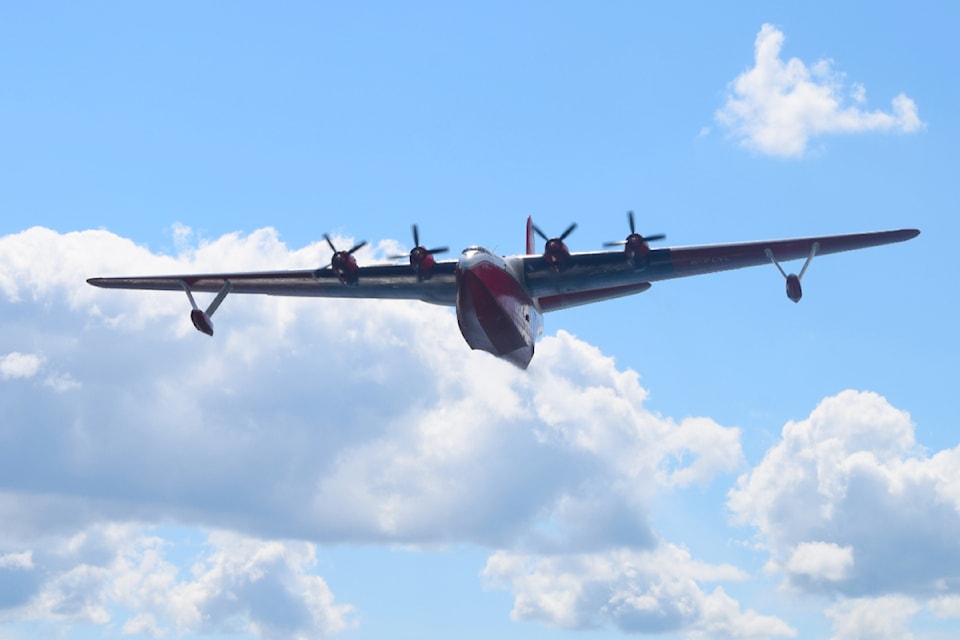Cheers rose up from Sproat Lake on Sunday afternoon as the historic Hawaii Martin Mars waterbomber lifted off from the water for the final time, heading to its new home in Victoria.
The water was filled with hundreds of boats, canoes and kayaks, while other spectators watched from the shore on Aug. 11, 2024. The iconic red-and-white waterbomber departed from the Sproat Lake Bomber Base,and circled around to fly over Port Alberni's Harbour Quay. It was scheduled to take a small tour of Vancouver Island's eastern coastline before it landed in Patricia Bay in Victoria on Sunday evening.
"It's the end of an era," said Uwe Goehl, who grew up in Port Alberni listening to the distinctive roar of the flying tankers' engines. Goehl, a pilot who now lives in Ontario, was at Sproat Lake to watch the Hawaii Mars' final flight.
At Piper's Lagoon, on Nanaimo's waterfront, dozens of people — many with cameras and flight tracking apps on their smartphones — waited to see the Hawaii Mars fly down the coast for a final time. "I came out here to see the last flight of the Martin Mars and it was awesome," said Bob Moore.
Moore was 12 years old when he first saw the Mars waterbombers. "Fighting the forest fire in Salmon Arm, over Mount Ida. They were both there that year (The Hawaii and Philippine Mars)."
Moore was also at Sproat Lake with his boat on Aug. 1 and said he lucked out seeing the Hawaii Mars make its first flight in eight years. "It was fantastic. I didn't think they were going to fly that day and then they hit the throttle and took to the air."
A huge welcoming party was waiting for the Hawaii Mars in Victoria for its final landing.
"That's where it first landed, you know, in 1959 or 1960," said Wayne Coulson, CEO of Coulson Aviation on Sunday. "It's going back to its resting spot. We just had it here [in Port Alberni] for 64 years."
The Hawaii Mars was one of five Martin Mars aircraft originally conceived as military bombers in the United States during the Second World War. It started service in 1945 as a transport aircraft for the United States Navy. After the war, it purchased by a consortium of timber companies in British Columbia and converted to a water bomber to protect the timber lands on Vancouver Island.
In 2006, it was sold — along with the Philippine Mars — to Coulson Aviation.
Although the aircraft hasn't taken part in firefighting action since 2015, Coulson says it has firmly established itself in British Columbia's firefighting history.
"There will never be a better firefighting aircraft, no matter what anybody says," said Coulson. "This thing drops four acres [of water] at a time. We've seen it do so much good work over the years. That airplane will live on forever through our existing air tanker program," he added.
The aircraft was set to arrive in Victoria on Sunday evening, in formation with all nine planes of the Canadian Forces Snowbirds demonstration team. This week, the plane will be dewatered and moved to the B.C. Aviation Museum in North Saanich, where it will be part of the museum's new B.C. wildfire aviation exhibit.
The new exhibit is expected to officially open to visitors on Saturday, Sept. 28. Visitors will have a chance to explore the inside of the aircraft and even sit in the pilot's chair.
The bomber's pilots, Rick Matthews and Peter Killin, will also become a part of history. They both wore specially designed flight suits on Sunday, which will be left behind in Victoria and will become a part of the museum exhibit.
Matthews and Killin, started together at Harbour Air in 1984, and have been piloting aircraft on the west coast for more than 50 years. Killin has logged more than 1,000 hours of flying time with the bomber.
"It's touching, it really is," said Matthews of the crowd gathered around the lake on Sunday. "When we first started this, three or four months ago, I had no idea how it would snowball into this kind of event."
The boats, he added, have been "respectful and courteous" about sharing the water with the bomber.
His copilot, Peter Killin, said he was not surprised by the reception — although he admitted he's never seen so many boats in the water before.
"It's all her supporters," he said. "I know this town, I know the lakers. That's the way it's been, for the 20 years I've been around here."
Coulson said they have been "humbled" by the amount of support the bomber has received from the community during its final flight.
"We've had several hundred people tour the airplane," he said. "We've been running it around the lake so everyone could enjoy it for the last part of its life, as far as flying. Now we're turning it over to the folks at the BC Aviation Museum."
"It's a new chapter," added Killin.



